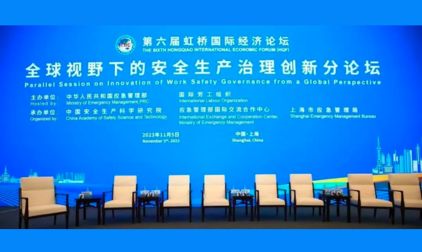
On November 5, 2023, the International Labor Organization (ILO) and the Ministry of Emergency Management (MEM) co-hosted a sub-forum on "Innovations in Work Safety Governance from a Global Perspective" at the 6th Hongqiao International Economic Forum. Safety and health at work affects all of us. Safe and healthy workplaces and workers are key prerequisites for productivity and sustainable development.
The theme of this sub-forum is "Innovation in Work Safety Governance from a Global Perspective", which is highly in line with the China International Import Expo's mission to promote China's drive to build an open world economy and support economic globalization. As one of the countries with the largest inflows and outflows of foreign direct investment (FDI), China has a very important role to play in promoting a safe and healthy working environment in a more open world economy. China has an unrivaled position in global value chains and can have a huge impact on working conditions, including safety and health at work, in global supply chains.
"Work safety without borders ...... Through this forum, we are willing to work with the International Labor Organization and our global production safety counterparts to analyze common contradictory problems in production safety, explore fundamental solutions to ideas and approaches, learn and exchange distinctive experiences and practices, and improve the modernization of the emergency management capacity and system...and actually improve the people's sense of well-being, access and safety."
Song Yuanming, Vice Minister of Emergency Management
"Safe and Healthy Working Environment" and the Declaration on Fundamental Principles and Rights at Work
The Declaration on Fundamental Principles and Rights at Work is an integral part of global governance and the multilateral trading system in the field of labor.
A growing number of free trade and investment agreements, such as the Comprehensive and Progressive Trans-Pacific Partnership (CPTPP), incorporate the ILO's Fundamental Principles and Core Conventions into their labor chapters or sustainable development chapters.
At the 2022 International Labor Conference, government, worker and employer representatives from the ILO's 187 member states unanimously adopted the inclusion of safe and healthy working conditions in the ILO's framework of fundamental principles and rights at work, and identified Convention No. 155 on Occupational Safety and Health and the Working Environment (1981) and Convention No. 187 on the Promotion of a Framework for Occupational Safety and Health ( (2006) have been identified as core conventions.
Progress and challenges of work safety in China
In the ten years from 2012 to 2022, the total number of work safety accidents and fatalities in China have decreased by 92.2% and 70.9% respectively, and the number of serious accidents and fatalities have decreased by 81.4% and 76.5% respectively. With advanced OSH management systems and rich experience in work safety management, many large enterprises in China are already global leaders in OSH management. However, gaps and deficiencies in safety and health at work are mainly concentrated in micro, small and medium-sized enterprises (MSMEs) and the informal sector. Large enterprises often have significant influence over their suppliers located downstream in the supply chain, which are usually MSMEs. Large enterprises should play a leadership, modeling and support role for these MSMEs, which is essential for improving overall work safety and healthy working conditions in global supply chains. At the same time, new technologies, processes and business models have brought many new risks and challenges, and it has become increasingly difficult to rely on traditional means and measures to bring about a significant reduction in serious accidents, which calls for the implementation and intensification of innovation in work safety governance.
Innovation in Work Safety Governance
When we talk about innovation in work safety governance, revolutionary technological advances, upgraded equipment, rapid automation, and artificial intelligence and machine learning present unprecedented opportunities. We have the potential to reduce safety risks to workers at a much lower cost and use predictive analytics to anticipate the likelihood of the next accident. However, in utilizing technology, it is particularly important to ensure that decisions on whether to use technology to improve safety and efficiency are made through social dialogue, i.e., consultation between businesses and workers. Collaboration in the workplace is also a catalyst for fostering a culture of prevention and preventive behaviors, and prevention is the foundation of any innovative solution for managing work safety.